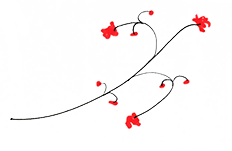Eulogy for Barbara Solís
Eulogy given at memorial service at St. Luke’s Anglican Church,
760 Somerset St. West, Ottawa, Canada
Friday, February 12, 2010, 7:00 pm
Good evening, all. It is a sad occasion for us to be here, of course, but I would like to thank the Solís family for having this memorial service here, and for bringing us together today to remember Barbara in all the ways that she influenced us, in some ways subtly and in other ways profoundly.
My relationship with Barbara was sometimes straightforward, and sometimes it presented complexities. But it was always enormously rewarding, and I trust that it was mutually so.
Barbara and I met 13 years ago through a connection at the Musical Arts Club of Ottawa. Barbara had emerged from her studio one day with the daring idea of her dancing to a musical arrangement she had created for solo viola, and someone thought it would be a good idea to for us to meet. I believe our first rehearsal was at the Glebe Community Centre. Afterward, she revealed that she was a pianist, among other things.
In fact, on that day, I learned that Barbara Solís had recently turned 65, that she danced, that she was a painter, that she had begun to explore arranging music, that she was a Bachelor of Music student at the University of Ottawa, that she had a passion for Spanish culture, and that she was utterly unlike anyone I had ever met. I had not yet heard her play a single note at the keyboard, but we must have recognized a quick connection, because later that year we appeared in the concert series at First Unitarian Congregation in a program she created titled “An Evening in Old Madrid.”
For Barbara, this first collaboration seemed to open the floodgates of her creativity in reconceiving some of the Spanish classical repertoire for piano as arrangements for piano with viola. In these arrangements, the viola is rarely centre stage but rather a partner in her exploration of colour and emphasis of musical line. Barbara became a master of this while studying with Steven Gellman at the University of Ottawa. I later asked her if she had ever considered piano with cello for her chosen instrumentation, but she was adamant that the sound of the viola was what she was looking for. This made me think quite deeply about what her model of musical sound was.
Barbara embarked on designing some unique programming, and the programming was indeed all hers: “The Romantic Music of Spain,” “The Mystical Music of Andalucia,” “The Exotic Music of Spain,” “Arabian Nights in Spain,” and “In the Caves of Sacromonte,” among others. Some were lecture-recitals at Carleton University, but most were concerts that we presented here, at St. Luke’s.
We rehearsed a great deal in Studio B at Carleton University, thanks to Dr. Elaine Keillor’s help and Connie Freitag’s administration. In Studio B, I think we did much of our best work – it became our workshop. Barbara was forever presenting new arrangements, always meticulously handwritten and amazingly accurate. She was unfailingly excited about her reading and research, and she asked pointed questions about string playing, such as what was possible and what was not. And of course there was always a very substantial discussion during our picnic breaks beside the piano.
It was in Studio B as well that I would present her with homemade recordings for her to practise her choreography with, and where she would run through her dances. I will never forget one, during which she deliberately threw her red carnation to the floor, saying, “That is what I am doing with my life.” I took that to mean that she wanted to shed all the props and move full steam ahead with the momentum of her art.
There were times, when Barbara was rethinking her direction, that she turned away from our partnership. And there were times when I was more silent than she wanted, usually because of some demonstration of her wisdom that sent me into a cave of my own to absorb what she was saying – sometimes with my instrument, but more often without it.
But we corresponded often, and some of this correspondence I still find remarkable. Barbara explored difficult topics of the spiritual realm, and I asked some challenging questions of the physical and practical realm. In this discourse, we found it helpful to speak in metaphors.
For Barbara, a recurring theme was letting go of the rock by the raging river – a rock that had provided a degree of comfort and stability – and risk where those raging waters would take her. For me, it was the suggestion that, even if we are discouraged, we are fortunate in our community to be able to experiment in our own sandbox and to contemplate artistic ideas, experiment, evaluate and publish.
This last idea seemed to capture Barbara, especially the sandbox part – she was an expert on the Arabian desert, after all – and this became the basis of our progress over the next several years. The culmination of our partnership was, of course, our CD together. When I listen to Barbara’s solo piano playing on that recording, I am so glad to have it. We often discussed a solo piano album as her next project, which I always wanted her to do and regret very much that we do not have.
Can you imagine, as a participant in all this, how rich and rewarding these experiences have been.
Barbara, you have given us many gifts, and as we explore them, we have so many fond memories of you as an artist, humanitarian and spiritual person. Thank you for the privilege of participating in your journey, and for how you welcomed us all with wisdom as we follow our own.
Kevin James
